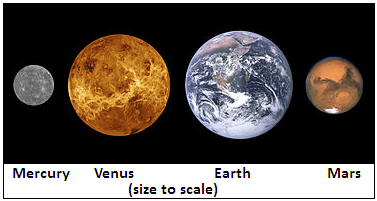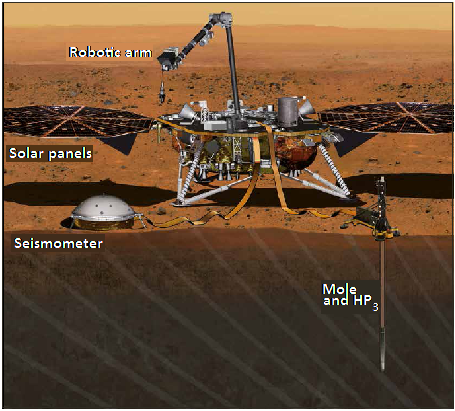A close look at the planet, Mars may tell us things about planet earth, says S.Ananthanarayanan.
The geologist, like the physician, learns things by watching heat flows. Just as the body is a machine whose processes generate heat, the internals of a planet are in motion and affect how heat flows out from its centre.
NASA’s mission, InSight has just completed its six-month journey to our neighbor planet, Mars and on Monday, 26th November, has made a landing at a selected spot, just north of the Mars equator. And InSight carries on board, the ‘Heat Flow and Physical Properties Package’ (HP3), a piece of equipment that can burrow into the Mars soil and measure variations in temperature down, to a depth of five metres. While NASA has managed the launch and flight, it is the German Aerospace Center ( known as DLR – for Deutsches Zentrum für Luft-und-Raumfahrt) that has constructed and would manage the penetration device, which has been evocatively nick-named the ‘Mole’. “It will be the deepest hole ever hammered into another celestial body using manmade technology”, says the information portal that DLR has created.
Mars, the fourth planet from the sun has many things in common with the earth. While Mercury and Venus, which are closer to the sun, are much hotter, Mars has sub-freezing surface temperature. But all these four planets are similar in structure, with a metallic core, mostly iron, surrounded by a molten mantle and then a crust of minerals. The origin of the planets is considered to the process of accretion, or the coming together of particles of dust that surrounded the sun during its own formation. While the fledgling planets grew and attracted more dust and rock the centres compressed to high pressures and temperatures rose enormously. There was radioactivity, in the young planets, that added to the heat and the inner region were molten and in the liquid state. In the liquid, the heavier parts, the metals, mostly iron, sank to the centre, while minerals formed the outer regions. In the case of the earth, which is the most massive of the first four planets, the pressure is so high that centre has solidified, nearly all iron, and is surrounded by molten metal and silica

Mars is about half the size of the earth and has about a tenth of the mass. It also has an iron core, covered by a silicate mantle. The tilt of its axis of rotation is 25.2°, which is near the 23.5° of the earth. Mars, hence, has seasons, just like the earth, through the course of its year, which is 687 earth days long. But, with less gravity, Mars, like the moon, has lost most of its atmosphere. With atmospheric pressure less than 1% of that of the earth, and average surface temperature of minus 60° C, there is no liquid water on Mars. Nevertheless, features like canyons and valleys suggest that there was water, ice and glaciers in the past, and the possibility that there was a form of life too
Planets, with their hot, often molten, cores, steadily lose heat by radiation from the surface. Convection currents within the core and mantle drive heat outwards, hot material sometimes spewing out in volcanoes. The temperature, however, falls as we approach the surface. The surface itself is heated by the sun, with a day-night cycle, greatly evened out when there is an atmosphere. While there is a feeble day-night temperature wave that passes inwards from the surface, the net result is gradual cooling of the planet, with increasing temperature as one moves closer to the centre
On the earth, the structure and conditions deep under the surface have been studied through bore holes and in mine-shafts, even borings into the bed of the deepest parts of the sea. We know, now, that it gets warmer by about 1°C for every 100 metres that we go deeper into the earth. The study of earthquakes and detecting tremors in the earth have revealed something of the structure of the crust and the mantle and the movement plates of material just above the softer, outer mantle. All this leads to ideas of the formation of the earth and planets, but there is great interest in knowing how it has worked in other planets.
Comparable studies are clearly not possible in other planets, even the nearby ones. While we have detailed pictures of the chemical composition and the atmosphere, of Mars and Venus, we have only visual images of surface, and nothing of what lies beneath. There have been several missions to Mars, mainly Orbiters and Landers and the Rovers, Spirit and Opportunity, which landed on the surface of Mars. But the investigations were only of the atmosphere and surface features of Mars. The only geological study outside the earth has been the Apollo programme and the Soviet Luna spacecrafts, which returned lunar rock and lunar soil for study on the earth.
Mission InSight, with DLRs HP3, the Mole, is the first time there would be investigation of the interior of a planet. And “Mars is the perfect destination, as it is relatively easy to reach and makes an ideal comparison object to Earth”, the German Aerospace Center (DLR) portal says. As Mars, when it was formed, would have cooled faster than the earth, indicators of the processes involved may be better preserved on Mars, the portal says.
The lander itself is a platform, two metres across, that rests on three telescopic legs. Minutes after landing, the solar panels, which stretch over six metres, are deployed, to provide over 600 watts of power, on a clear day. The platform has a camera that maps the terrain to locate the best spot to place the two main equipment – an ultra-sensitive seismometer, the sensor of surface movements, and the Mole, the device to bore into the ground, with HP3, the arrangement to measure heat flow. And there is a robotic arm that would install the two pieces devices on the ground. The placement may take ten weeks, the DLR mission brochure says.

The heat sensing arrangement consists of a drilling tower, with a 40 cm long and 27 mm wide penetrating device that can hammer down to a depth of five metres into the Martian soil. And there is a casing that contains measuring and data cables, to convey data from platinum temperature sensors up to the computers in the landing craft, and thence to an orbiting relay station. The measuring accuracy of the sensors is a thousandth of a degree.
The collected data of the surface conditions and the rate of cooling, by flow of heat from the interior, on Mars, along with data of the seismic, or Marsquake-like, activity, would open a new chapter in our understanding of the structure of Mars. And hence of interpreting what we know about the earth. And then, in what directions we need to design future experiments or missions to Mars!
------------------------------------------------------------------------------------------ Do respond to : response@simplescience.in-------------------------------------------